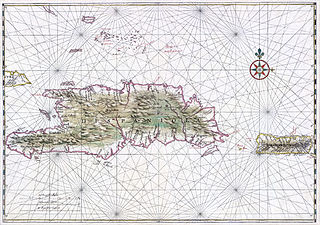
The recorded history of the Dominican Republic began in 1492 when the Genoa-born navigator Christopher Columbus, working for the Crown of Castile, happened upon a large island in the region of the western Atlantic Ocean that later came to be known as the Caribbean. It was inhabited by the Taíno, an Arawakan people, who called the eastern part of the island Quisqueya (Kiskeya), meaning "mother of all lands." Columbus promptly claimed the island for the Spanish Crown, naming it La Isla Española, later Latinized to Hispaniola. After 25 years of Spanish occupation, the Taíno population in the Spanish-dominated parts of the island drastically decreased through genocide. With fewer than 50,000 remaining, the survivors intermixed with Spaniards, Africans, and others, forming the present-day tripartite Dominican population. What would become the Dominican Republic was the Spanish Captaincy General of Santo Domingo until 1821, except for a time as a French colony from 1795 to 1809. It was then part of a unified Hispaniola with Haiti from 1822 until 1844. In 1844, Dominican independence was proclaimed and the republic, which was often known as Santo Domingo until the early 20th century, maintained its independence except for a short Spanish occupation from 1861 to 1865 and occupation by the United States from 1916 to 1924.

Juan Pablo Duarte y Díez was a Dominican military leader, writer, activist, and nationalist politician who was the foremost of the founding fathers of the Dominican Republic and bears the title of Father of the Nation. As one of the most celebrated figures in Dominican history, Duarte is considered a national hero and revolutionary visionary in the modern Dominican Republic, who along with military general Ramón Matías Mella and Francisco del Rosario Sánchez, organized and promoted La Trinitaria, a secret society that eventually led to the Dominican revolt and independence from Haitian rule in 1844 and the start of the Dominican War of Independence.

Cotuí is a city in the central region of the Dominican Republic and is one of the oldest cities of the New World. It is the capital of Sánchez Ramírez Province in the Cibao.

Francisco del Rosario Sánchez was a Dominican revolutionary, politician, and former president of the Dominican Republic. He is considered by Dominicans as the second leader of the 1844 Dominican War of Independence, after Juan Pablo Duarte and before Matías Ramón Mella. Widely acknowledged as one of the founding fathers of the Dominican Republic, and the only martyr of the three, he is honored as a national hero. In addition, the Order of Merit of Duarte, Sánchez and Mella is named partially in his honor.

Pedro Santana y Familias, 1st Marquess of Las Carreras was a Dominican military commander and royalist politician who served as the president of the junta that had established the First Dominican Republic, a precursor to the position of the President of the Dominican Republic, and as the first President of the republic in the modern line of succession. A traditional royalist who was fond of the Monarchy of Spain and the Spanish Empire, he ruled as a governor-general, but effectively as an authoritarian dictator. During his life he enjoyed the title of "Libertador de la Patria."

The Dominican War of Independence was a war of independence that began when the Dominican Republic declared independence on February 27, 1844 and ended on January 24, 1856. Before the war, the island of Hispaniola had been united for 22 years when the newly independent nation, previously known as the Captaincy General of Santo Domingo, was unified with the Republic of Haiti in 1822. The criollo class within the country overthrew the Spanish crown in 1821 before unifying with Haiti a year later.

The first siege of Zaragoza was a bloody struggle in the Peninsular War (1807–1814). A French army under General Lefebvre-Desnouettes and subsequently commanded by General Jean-Antoine Verdier besieged, repeatedly stormed, and was repulsed from the Spanish city of Zaragoza in the summer of 1808.

General Pedro Alejandrino Florentino was an Dominican officer in the army of the Dominican Republic. A native of Hincha, be was an active participant in border conflicts during the Dominican War of Independence. He was the hero of the important Battle of Sabana Larga. He later participated in the Dominican Restoration War, along with Gregorio Luperón, against Spain.

The Dominican Restoration War or the Dominican War of Restoration was a guerrilla war between 1863 and 1865 in the Dominican Republic between nationalists and Spain, the latter of which had recolonized the country 17 years after its independence. The war resulted in the restoration of Dominican sovereignty, the withdrawal of Spanish forces, the separation of the Captaincy General of Santo Domingo from Spain, and the establishment of a second republic in the Dominican Republic.

Spanish reconquest of Santo Domingo was the war for Spanish reestablishment in Santo Domingo, or better known as the Reconquista, and was fought between November 7, 1808, and July 9, 1809. In 1808, following Napoleon's invasion of Spain, the criollos of Santo Domingo revolted against French rule and their struggle culminated in 1809 with a return to the Spanish colonial rule for a period commonly termed España Boba.

The Battle of Palo Hincado was the first major battle of the Spanish reconquest of Santo Domingo of the Spanish colonial Captaincy General of Santo Domingo, that was occupied by the French in the Spanish West Indies. The site is in the present-day Dominican Republic, on the island of Hispaniola in the Caribbean.

In the history of the Dominican Republic, the period of España Boba lasted from 9 July 1809 to 1 December 1821, during which the Captaincy General of Santo Domingo was under Spanish rule, but the Spanish government exercised minimal powers because its resources were attenuated by the Peninsular War and the various Spanish American wars of independence. The period ended when Dominican officials declared a short-lived independence on 30 November 1821. In February 1822, Haiti annexed former Santo Domingo, leading to an occupation that lasted until 1844.

In the history of the Dominican Republic, the period of Era de Francia occurred in 1795 when France acquired the Captaincy General of Santo Domingo, annexed it into Saint-Domingue and briefly came to acquire the whole island of Hispaniola by the way of the Treaty of Basel, allowing Spain to cede the eastern colony as a consequence of the French Revolutionary Wars.

José Núñez de Cáceres y Albor was a Dominican politician and writer. He is known for being the leader of the independence movement against Spain in 1821 and the only president of the short-lived Republic of Spanish Haiti, which existed from December 1, 1821, to February 9, 1822. This period was known as the ephemeral independence because it quickly ended with the Haitian Military Occupation of Santo Domingo

Juan Sánchez Ramírez was a Dominican soldier who served as the Captain general of the modern Dominican Republic between 1808 and 1811. He also commanded the troops that fought against the French rule of Santo Domingo´s colony between 1808 and 1809 in the Battle of Palo Hincado, resulting in a victory over the French, and the return of Santo Domingo to Spanish hands.

Rafael Conti Flores, also spelled "Conty" was a Colonel in the Spanish Army who was in charge of the Puerto Rican Militia in the town of Aguadilla. In 1790, he captured 11 enemy ships involved in smuggling stolen goods. In 1797, he helped defeat Sir Ralph Abercromby and defend Puerto Rico from a British invasion in Aguadilla. In 1809, he organized a military expedition fight with the aim of returning Hispaniola, which now comprises the nations of the Dominican Republic and Haiti, back to Spanish rule.

Lieutenant-General Sir Hugh Lyle Carmichael (1764–1813), was a British officer of the 2nd West India Regiment. He was Commander-in-Chief of the British Forces at the Siege of Santo Domingo. He was Lieutenant Governor of Demerara Essequibo from 1812 until his death the following year. He was a strong proponent of giving native Caribbean troops the same rights as ordinary British soldiers.

Dominican Republic–Haiti relations are the diplomatic relations between the Dominican Republic and Haiti. Relations have long been hostile due to substantial ethnic and cultural differences between the two nations and their sharing of the island of Hispaniola, part of the Greater Antilles archipelago in the Caribbean region. The living standards in the Dominican Republic are considerably higher than those in Haiti. The economy of the Dominican Republic is ten times larger than that of Haiti. The migration of impoverished Haitians and historical differences have contributed to long-standing conflicts.

The Beheadings of Moca was a massacre that took place in Santo Domingo in April 1805 when the invading Haitian army attacked civilians as ordered by Jean-Jacques Dessalines and Henri Christophe, during their retreat to Haiti after the failed attempt to end French rule in Santo Domingo. The event was narrated by survivor Gaspar Arredondo y Pichardo in his book Memoria de mi salida de la isla de Santo Domingo el 28 de abril de 1805 , which was written nearly 40 years after the massacre is said to have taken place. The broader invasion was part of a series of Haitian invasions into Santo Domingo, and occurred after the return from the Siege of Santo Domingo (1805). Haitian historian Jean Price-Mars wrote that the troops killed the inhabitants of the targeted settlements irrespective of race.



















